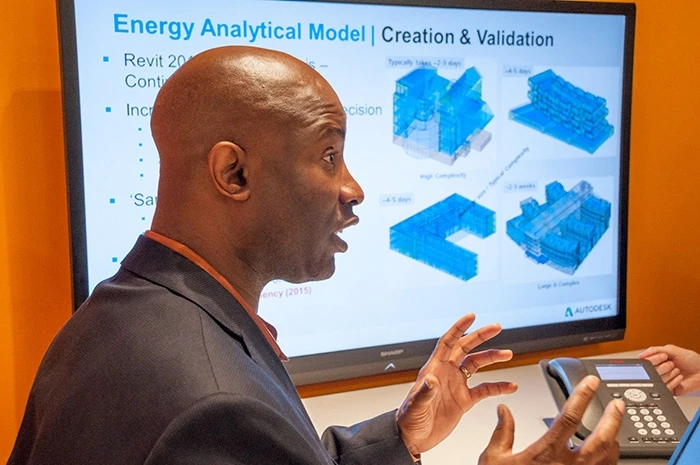& Construction

Integrated BIM tools, including Revit, AutoCAD, and Civil 3D
& Manufacturing

Professional CAD/CAM tools built on Inventor and AutoCAD
Prioritizing sustainability is no longer an optional approach for architects. This is a make-or-break moment to define how the built environment impacts climate change. It’s make-or-break time to hit energy independence on a global level. It also can be make or break for the survival of an architecture or design firm and its business.
During the past few weeks and months, reality has landed in new ways. The recent UN report on limiting global warming shows a clear turning point in the urgency and attitude toward bold action. Sanctions have awakened countries to how they must look to alternative solutions to do what has proven elusive: curbing carbon emissions.
Sustainability only works when woven into the DNA of the firm. It has to influence proposals, process, and projects. It’s really about taking responsibility for the buildings the firm is bringing into the world.
Many firms still grapple with how to build a sustainability-first mindset. As director of sustainability at CannonDesign, I see my role as supporting everyone across the entire firm to make their projects better for clients. It’s part of the culture to make every project a green project. Here, I’ll share some ways architects can lead with sustainability, and how you can make sustainability happen in your own firm.
You can’t look at sustainability like it’s cinnamon or paprika, sprinkling it on at the end. It must be integrated from the start. Otherwise, it will always be seen as an extra that can be eliminated. View sustainability for what it is: an innovation strategy.
Our firm makes sure sustainability support is available from the very beginning of a project. Starting with the proposal, sustainability is woven throughout our communication and approach. At the start of the project, we kick off with a sustainability workshop to map out the priorities and desired outcomes.
The first thing I tell our project managers is, “You can’t put sustainability at the bottom of your agenda.” Instead, put sustainability at the top of the agenda and then frame everything through a sustainability lens. When it’s time to talk about the HVAC or lighting, do it with a sustainable approach in mind. Changing your agenda to put sustainability at the top is a very powerful, yet easy, thing to do.
Sustainability is urgently needed for all clients, even if they don’t realize it yet. Virtually all of our clients have some sort of sustainability plan, and most have science-based targets for reducing their carbon. Yet everyone is struggling to achieve these goals.
The first thing we ask a client is: “I see on your website that you’re seeking to be carbon-neutral by 2040. How is this project helping to get you to that goal?” Most of them have no idea. They see two siloed ideas: climate targets set by the C-suite versus bringing a project in on budget set by the facilities team.
It’s vital to make that connection between those two silos. It starts by connecting the current projects to the organization’s larger sustainability commitments. Right off the bat, ensure each building will contribute to a client’s overarching sustainability commitments.
There’s an old saying in business, and it’s certainly true in sustainability: “If it gets measured, it gets managed.” The whole premise of the LEED rating system centers around this idea of measurement. But it also raises a question: Are designers measuring the right things? That’s where the idea of an outcomes-based approach to sustainability comes in.
If you’re designing a school, boosting student test outcomes is probably pretty important. If you’re designing a hospital, boosting patient recovery outcomes is important. So at the beginning of the project, work with clients to establish clear outcomes and design the project toward those outcomes. The result is a sustainability strategy that targets what’s important to your client.
Many companies have tied carbon commitments to a specific date. If they have a 2040 or 2050 plan to be carbon-neutral, you should consider that a “today plan.” You need to put it in action today because 80% of the carbon cuts need to be completed by 2030, which is only 92 months away and ticking closer and closer.
Humans, as a species, are very good at ignoring the urgency of risk. When there’s a 2040 goal, the mentality is often, “Oh, we have until 2039 to deal with it.” That’s simply not true. We have many clients that are really bold and progressive. They have carbon commitments starting in 2025. Well, that’s less than 30 months away. We can provide a month-by-month climate action plan to help them get there. Every climate action plan has to be a “today plan.”
Architects have no trouble jumping early into Autodesk Revit and modeling whatever they want, even if it’s just a portion of the building. Architects should apply the same mindset to energy performance. It’s never too early to start modeling the building and building the energy model, too.
Consider creating massing and energy models right at the beginning of design. Our engineers like to say, “We’re modeling at the speed of design”—which is exactly how it should work when sustainability is built in from the beginning. The energy model informs and evolves in Revit as you go—achieving your outcomes; helping clients meet their sustainability goals; and, most important, helping make a climate difference.>
Eric Corey Freed is an award-winning architect, author, and global speaker. As Senior Vice President of Sustainability for CannonDesign, he leads the healthcare, education, and commercial teams toward better and higher-performing buildings for more than 2 million square feet a year. For two decades, he was Founding Principal of organicARCHITECT, a visionary design leader in biophilic and regenerative design.
AECO
AECO
AECO
Image created in Midjourney by Stephen Coorlas.






